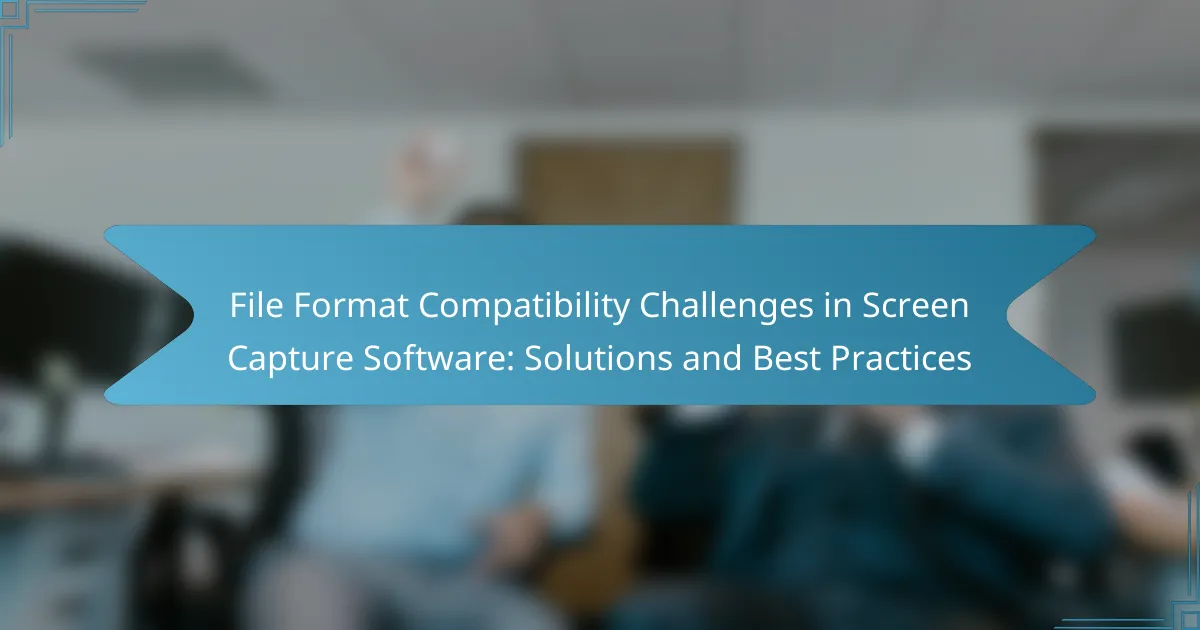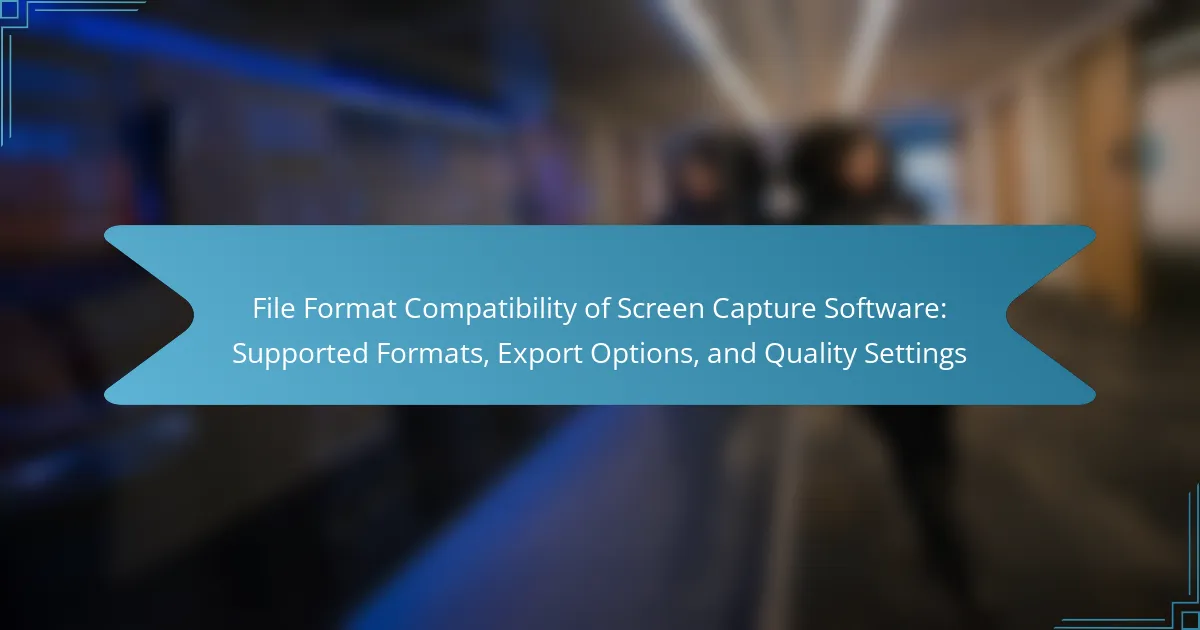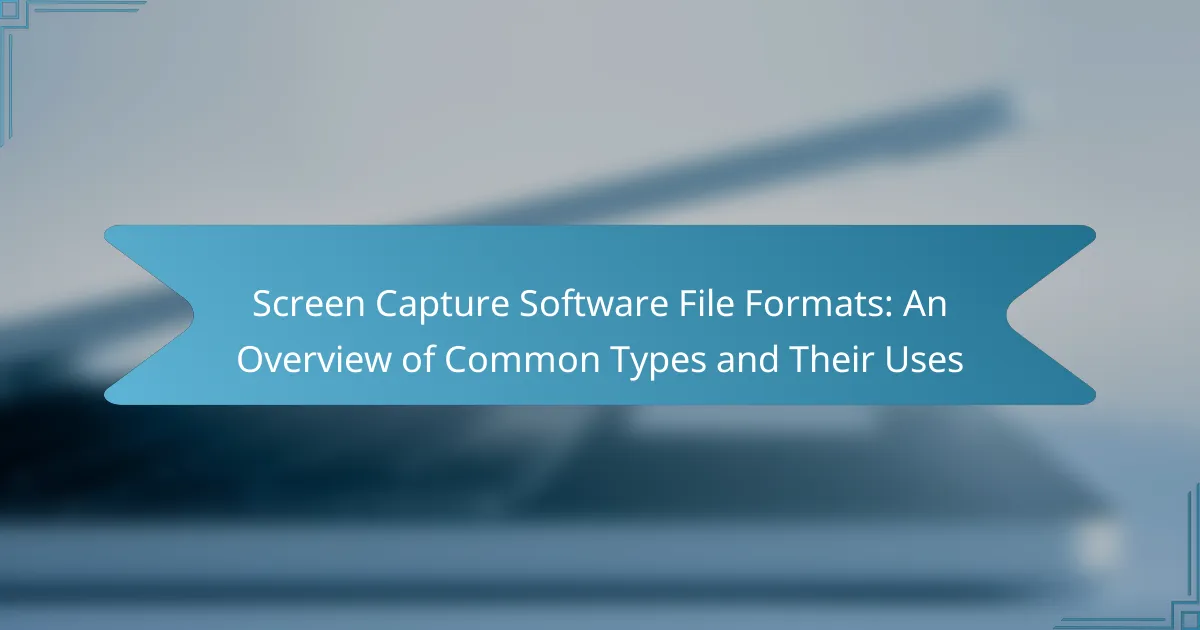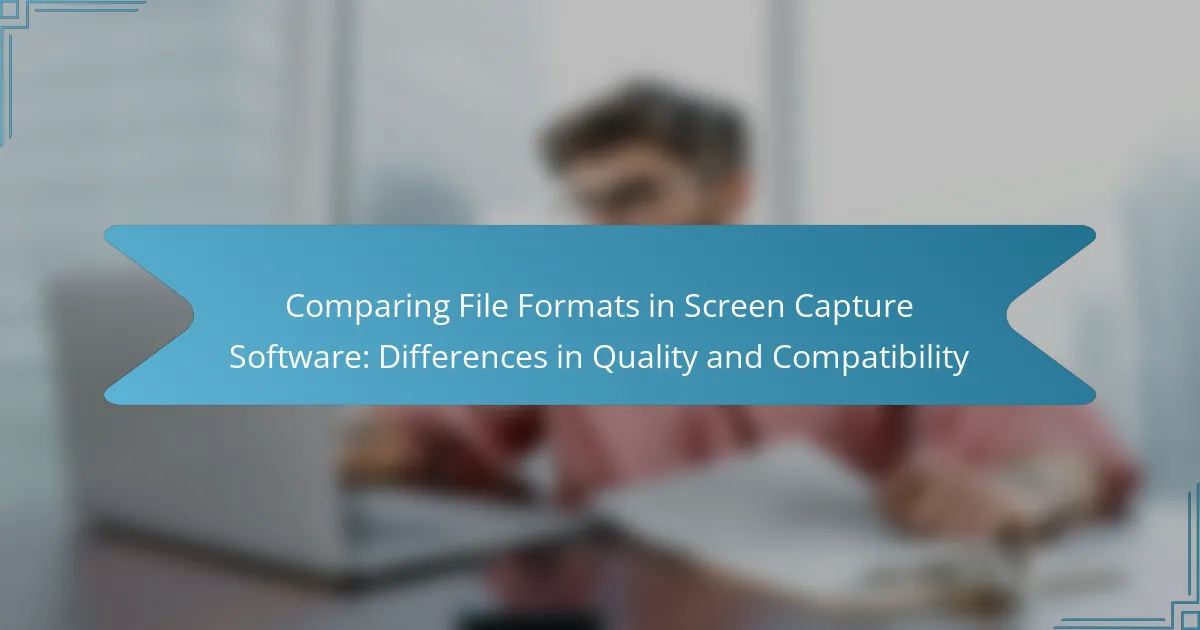Screen capture software often encounters file format compatibility challenges that can affect user experience. Various software applications support different formats, including MP4, AVI, and GIF, each with potential quality retention issues across platforms. Additionally, specific operating systems may not natively support certain formats, leading to difficulties in sharing, editing, or playback of captured content. Outdated software versions can further exacerbate these incompatibility problems. This article highlights the importance of understanding supported formats and offers solutions and best practices for effective use of screen capture software.
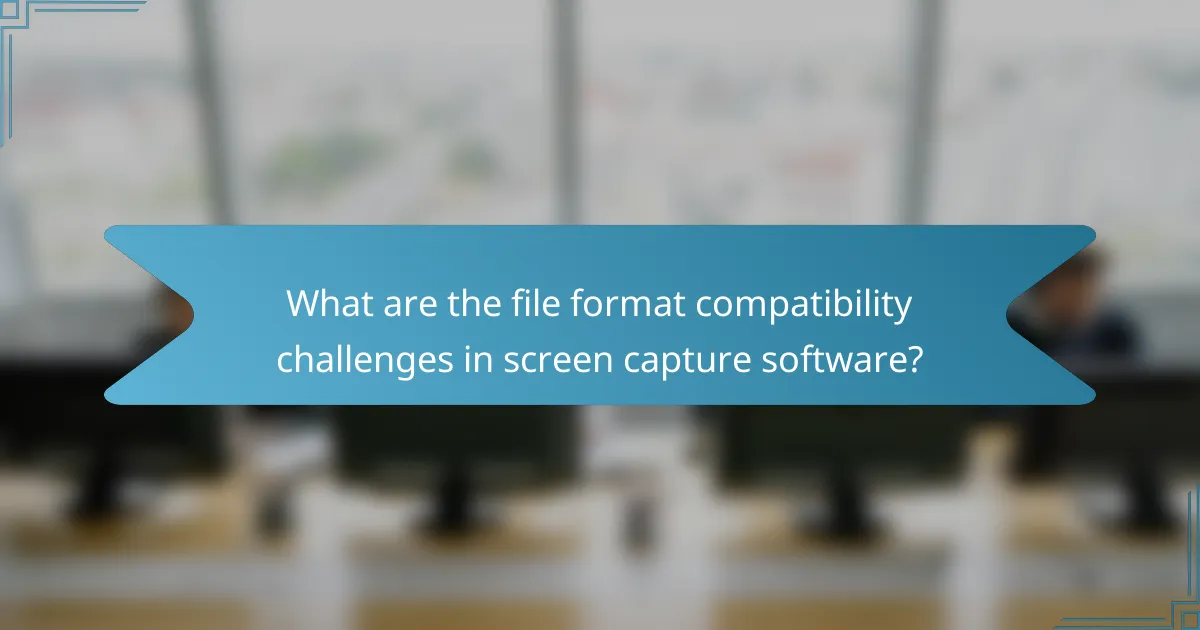
What are the file format compatibility challenges in screen capture software?
Screen capture software faces several file format compatibility challenges. Different software applications support various file formats like MP4, AVI, and GIF. Some formats may not retain quality across different platforms. Certain operating systems may not support specific formats natively. This can lead to issues when sharing captured content. Users may experience difficulties when trying to edit or play back files. Incompatibility can also arise from outdated software versions. These challenges necessitate awareness of supported formats for effective use.
How do different file formats affect screen capture quality?
Different file formats significantly impact screen capture quality. Common formats include PNG, JPEG, and BMP. PNG is lossless, preserving image quality without compression artifacts. JPEG uses lossy compression, which can reduce quality, especially at lower settings. BMP files are uncompressed, offering high quality but larger file sizes. Screen captures in PNG maintain sharpness and detail, making them ideal for graphics and text. JPEG is suitable for photographs where smaller file sizes are prioritized over perfect quality. BMP is less commonly used due to its large size, but it retains full fidelity. Therefore, the choice of file format directly influences the clarity and usability of screen captures.
What are the common file formats used in screen capture software?
Common file formats used in screen capture software include PNG, JPEG, BMP, GIF, and MP4. PNG is popular for its lossless compression and transparency support. JPEG is widely used for its balance between quality and file size. BMP is a raw image format, often larger in size. GIF supports animation and is suitable for short clips. MP4 is commonly used for video recordings. These formats ensure compatibility across various platforms and devices, enhancing usability.
How does compression impact file size and quality in screen captures?
Compression reduces file size in screen captures by eliminating redundant data. This process can lead to a loss of image quality, particularly with lossy compression methods. For example, JPEG compression can reduce file sizes significantly but may introduce artifacts, blurring, or loss of detail. Conversely, lossless compression retains original quality but results in larger file sizes. Research indicates that lossy formats can reduce file sizes by up to 90% compared to uncompressed formats, while maintaining acceptable visual quality for many applications. Therefore, the choice of compression method directly affects both file size and visual fidelity in screen captures.
Why is file format compatibility important in screen capture software?
File format compatibility is crucial in screen capture software because it ensures the captured content can be easily shared and viewed across different platforms. Without compatibility, users may face issues with file accessibility and usability. Different operating systems and applications support various formats. For instance, JPEG and PNG are widely accepted for images, while MP4 is standard for video. Incompatibility can lead to loss of quality or functionality. Additionally, users may need to convert files, which can be time-consuming and may introduce errors. Therefore, having versatile file format options enhances user experience and productivity.
How does compatibility influence user experience and workflow?
Compatibility significantly influences user experience and workflow by ensuring seamless integration of software and file formats. When screen capture software is compatible with various file formats, users can easily share and edit captured content. This reduces frustration and time spent on conversions. A study by TechSmith found that 70% of users prefer software that supports multiple formats for better collaboration. Additionally, compatibility minimizes errors during file transfers, enhancing overall productivity. Users can focus on their tasks rather than troubleshooting format issues. Thus, compatibility is crucial for an efficient and satisfying user experience.
What are the risks of using incompatible file formats?
Using incompatible file formats can lead to data loss and corruption. When software cannot recognize a file format, it may fail to open the file. This results in users being unable to access important information. Additionally, incompatible formats can cause errors during file transfer or sharing. Such errors may lead to incomplete or distorted data. In some cases, users may need to convert files, which can further complicate the process. Moreover, reliance on incompatible formats can hinder collaboration among team members. Overall, these risks can significantly impact productivity and efficiency in workflows.
What are the common solutions for file format compatibility issues?
Common solutions for file format compatibility issues include using universal file formats, converting files, and updating software. Universal formats like PDF or JPEG are widely accepted across platforms. Converting files to compatible formats can resolve issues when sharing with others. Software updates often include improved compatibility features. Additionally, using dedicated conversion tools can facilitate file format changes. Lastly, checking system requirements can help ensure compatibility before using specific software.
How can users convert file formats effectively?
Users can convert file formats effectively by utilizing dedicated file conversion software or online services. These tools support various formats, ensuring compatibility across different platforms. Users should first identify the source file format and the desired target format. Next, they can select a reliable conversion tool that meets their needs. Many tools offer batch conversion, which saves time for multiple files. Users must also review the output settings to maintain quality during conversion. It’s essential to verify the converted file for functionality and integrity. Popular tools, like HandBrake and CloudConvert, provide user-friendly interfaces and support numerous formats.
What tools are available for troubleshooting compatibility problems?
Compatibility troubleshooting tools include software like Compatibility Mode in Windows, which allows users to run applications in an environment mimicking previous versions of the operating system. Another tool is the Dependency Walker, which analyzes executable files to identify missing DLLs and other dependencies. Additionally, virtual machines can simulate different operating systems to test software compatibility. Tools like FileFormat.info provide information on file formats and their compatibility. Each of these tools helps users diagnose and resolve compatibility issues effectively.
How can best practices improve file format compatibility in screen capture software?
Best practices can enhance file format compatibility in screen capture software by standardizing output formats. Utilizing widely accepted formats like PNG or MP4 ensures broader compatibility across devices and platforms. Implementing consistent encoding settings minimizes playback issues in various media players. Regularly updating software helps maintain compatibility with evolving file standards. Testing outputs on multiple systems identifies potential compatibility problems early. Encouraging user feedback can highlight common issues and drive improvements. Documentation of supported formats aids users in selecting the right options. Collectively, these practices lead to a more reliable user experience and fewer format-related challenges.
What guidelines should users follow when selecting file formats?
Users should consider compatibility, quality, and file size when selecting file formats. Compatibility ensures the format works with intended software and devices. Common formats like PNG and JPEG are widely supported. Quality refers to how well the format preserves image clarity. Lossless formats like PNG maintain quality better than lossy formats like JPEG. File size impacts storage and sharing efficiency. Smaller files are easier to upload and share but may sacrifice quality. Users should also consider the purpose of the file. For example, PNG is ideal for graphics, while MP4 is better for video. Understanding these guidelines helps users make informed decisions for effective screen capture.
How can regular updates enhance compatibility and functionality?
Regular updates enhance compatibility and functionality by integrating the latest file formats and standards. These updates ensure that screen capture software can work seamlessly with new operating systems and hardware. Compatibility with emerging technologies is crucial as it prevents software from becoming obsolete. Updates also fix bugs that may hinder performance and introduce new features that improve user experience. For instance, a study by TechRadar indicates that software with frequent updates shows a 30% increase in user satisfaction due to enhanced performance and reliability. Furthermore, maintaining compatibility with third-party applications is essential for workflow efficiency. Thus, regular updates are vital for optimizing both compatibility and functionality in screen capture software.
What tips can help users navigate file format compatibility challenges?
To navigate file format compatibility challenges, users should first identify the required file formats for their specific applications. Knowing the supported formats of the software can prevent issues. Users should also convert files using reliable conversion tools when necessary. This ensures that the content remains intact. Additionally, keeping software updated can resolve compatibility issues as updates often include new format support. Users should also consider using universal formats like MP4 or PDF, which are widely accepted. Checking documentation or support forums can provide insights into common compatibility problems. Finally, testing files in the target software before final use can help identify issues early.
File format compatibility challenges in screen capture software can significantly affect user experience and productivity. This article outlines the various file formats commonly used, such as MP4, PNG, and JPEG, and discusses how different formats impact quality and usability. It further explores the importance of compatibility, risks associated with incompatible formats, and common solutions, including conversion tools and best practices for selecting and managing file formats effectively. Users will gain insights into troubleshooting compatibility issues, enhancing workflow, and ensuring seamless integration across platforms.
